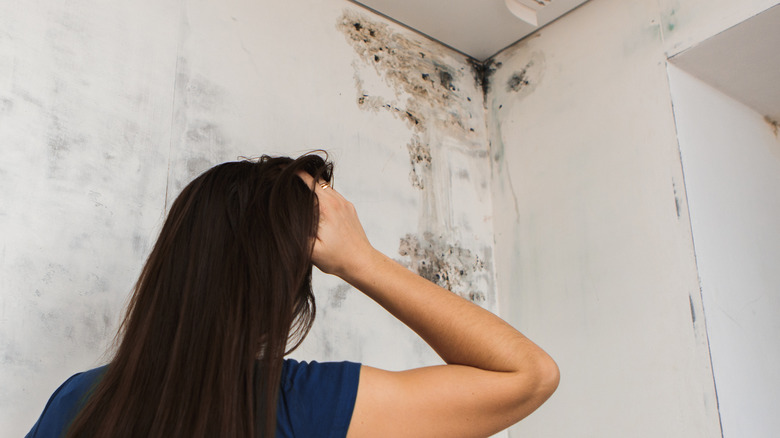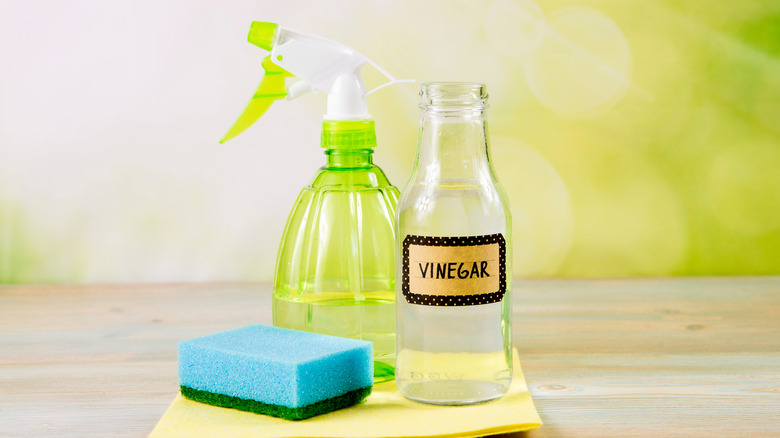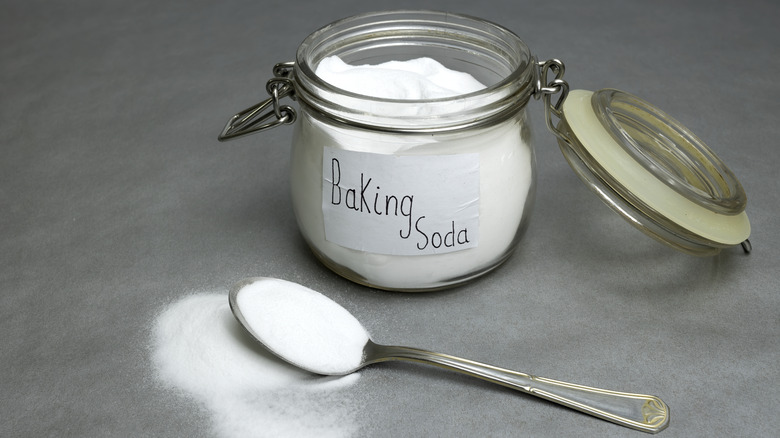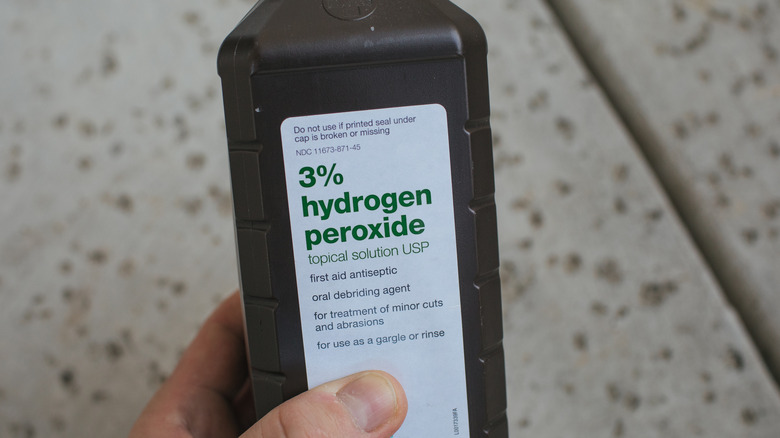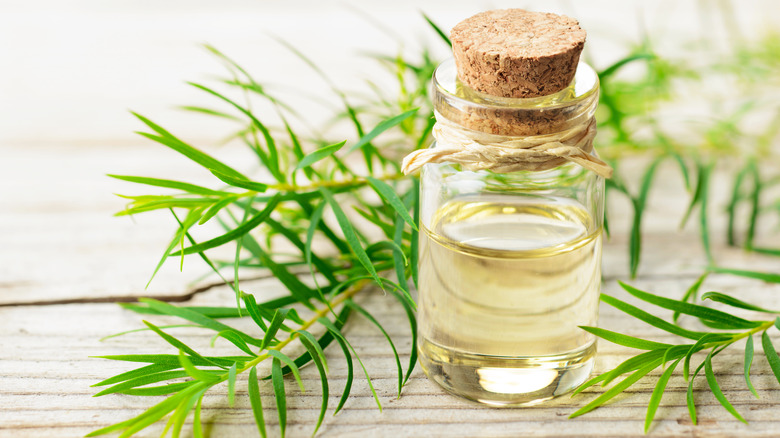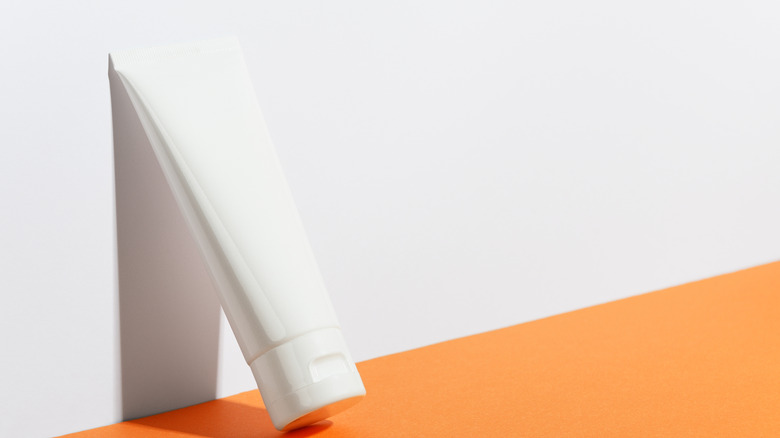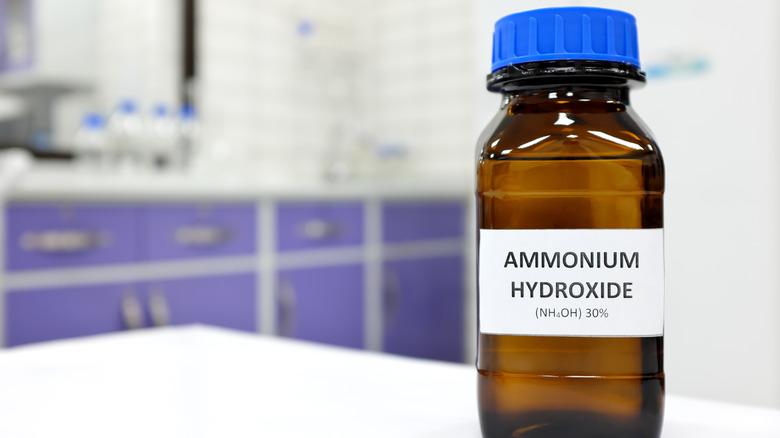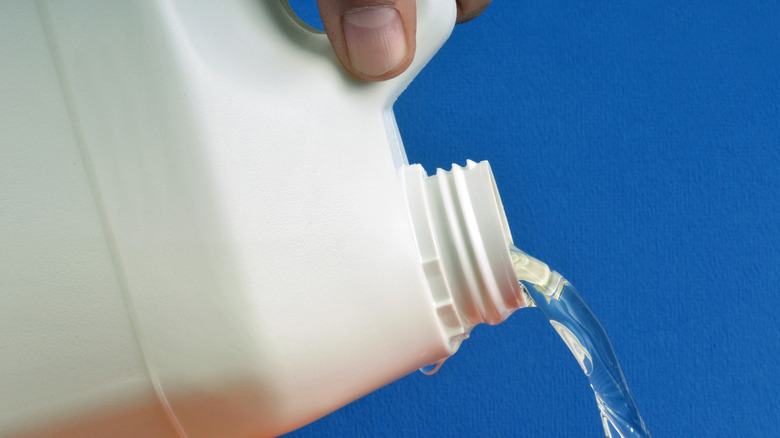The Best Ways To Get Rid Of Black Spots In Your Bathroom
Have you ever been enjoying a nice bath only to look up and see black spots in the bathroom ceiling spreading away? Yuck. It's an issue that no one wants to deal with, yet it happens all the time in bathrooms — especially if you live in a humid climate. Nobody wants their bathroom to become a fungus breeding ground, yet that's what happens when we put off cleaning for too long. Regular black spots are annoying and easy to eradicate, but you must act quickly if you see or smell black mold.
According to the Centers for Disease Control and Prevention, black spots can cause skin irritation, nasal stuffiness, throat discomfort, coughing or wheezing, and eye irritation. And, even more concerning, people with weakened immune systems are more susceptible to deadly lung infections when exposed to mold. The good news is that you don't have to put up with those black spots for the rest of your life. With a few products and a little elbow grease, you can learn how to remove black spots in the bathroom.
1. Vinegar
The best and most effective way to eradicate mold from the bathroom ceiling is to wash the affected area with undiluted vinegar. Use a spray bottle or sponge to apply it to the affected area, then leave the mixture for an hour before wiping it clean with a brush. For a better result, spray once more, then allow it to sit for 30 more minutes before rinsing with warm water.
Remember to keep the bathroom ventilated and to regulate moisture as much as possible to avoid mold from forming in the bathroom again. For instance, when showering, use a bathroom exhaust fan, open a window, or use a squeegee to remove any remaining moisture. Basically, you need to take all the necessary precautions to avoid breathing in mold or mold spores, a brief mold guide from Healthline advises. To prevent black spot formation in the future, keep a spray bottle full of vinegar in the bathroom and spray your bath and shower after each usage.
2. Baking soda
Baking soda solutions are fantastic at restoring mold-covered porous surfaces like walls or painted ceiling tiles. The solution won't eradicate black spots completely, but it will keep the caulk and grout in the bathroom dry, helping you avoid mold from spreading in the future. According to a study posted in the journal Mycopathologia, scientists managed to demonstrate that a concentration of 10 g/l of baking soda hinders the growth of 80% of all molds, making baking soda one of the most potent solutions against black spots.
For the magic mixture, you need baking soda, some water, and a scrub brush, suggests Country Living. Fill a container with the baking soda and water solution and spray the affected area. After scrubbing, rinse it with water and repeat the process. Finally, allow the solution to dry on the area to avoid future molding. If you'd rather use a paste, you can make a thick adhesive-like mixture of baking soda and a little water. Allow the paste to sit for 20 to 30 minutes after spreading it out, and rinse the surface after washing the mold with a brush.
3. Hydrogen peroxide
If the black spots in your bathroom persist after using vinegar or baking soda, consider spraying the area with hydrogen peroxide. Be cautious, however, that combining vinegar and hydrogen peroxide can result in toxic outcomes, The Whole Potion warns. Therefore, it's critical to properly cleanse surfaces after using vinegar before using any other cleaning agent. And, of course, don't mix the two ingredients in the same spray container.
Hydrogen peroxide has proven to be one of the most effective disinfectants ever devised by humanity, as noted by Bob Vila. Its extraordinary oxidizing properties result from an unbound oxygen atom, and its disinfection properties are a byproduct of that. To concoct a mixture to effectively get rid of black spots, pour 3% hydrogen peroxide in a bottle and saturate the surface with it. Leave for 15 minutes, then scrub the area to make sure you remove all the stains.
4. Tea tree essential oil
Aromatherapy has become a trend, thanks to numerous types of essential oils that can do wonders for people's health and mental wellness. However, these natural compounds can do so much more. For instance, tea tree oil is a natural insect repellent, antiseptic, and deodorizer, as well as one of the safest ways to get rid of black mold (via Damp Solving). In addition, tea tree oil is a natural fungicide that kills mold spores and helps prevent them from returning.
To use tea tree oil for your black spots issues in the bathroom, combine 1 teaspoon of the oil with 1 cup of water in a spray bottle and shake briskly to mix them. Next, spray the moldy area, wait an hour for it to dry, then wipe it clean with a microfiber cloth or a dry towel. However, when using this solution, keep in mind that Tisserand Institute recommends wearing protective gloves because essential oils can irritate some people's skin.
5. Lemon juice
Lemons are a natural deodorizer, antiseptic, bleach, stain remover, and cleaner, and black spot remover. As Cleanpedia writes, lemons' strong acid content breaks down mold, making it easier to remove and leaving a clean surface behind. Plus, there's that beautiful citrus scent!
To make the mixture, squeeze 3 to 5 lemons in a cup and pour the juice over the moldy area (via Country Living). You can also add a bit of water if you think the mixture is too concentrated. Allow the product to sit for at least five minutes before washing it down with a moist cloth. If there are still traces of stubborn mold stains, simply reapply the lemon juice and scrape the surface. Natural solutions like this one are efficient against mildew, making them fantastic non-toxic alternatives to chemical-based black spot removers. In addition, they're safe for your family and the environment, and they're often less expensive than commercial alternatives.
6. Toothpaste
Toothpaste is excellent for removing stains from your teeth, but few know it is also a fantastic cleaning agent that can help you get rid of almost any stain in your home. According to The Spruce, there are many uses for toothpaste, but not many know that this product also is excellent for cleaning up difficult mold spots in your bathroom.
Simply scrub a white toothpaste (do not use gel) on black spots in the bathroom, including ceilings, tiles, sinks, showers, and any other surface. All you need to do is squeeze some toothpaste onto the moldy area and gently scrub it away. Still, remember to be careful not to scrub too hard on softer materials and make sure you test-spot if necessary. If the spots are stubborn, moisten the bristles of a cleaning toothbrush with water to remove the mold completely. Once you're done, wipe down the area with a dry fabric.
7. Ammonia
Ammonia is an excellent chemical for eradicating mold, particularly in difficult-to-clean or difficult-to-reach areas (per Home Healthy Homes). Mix ammonia with water 1:1 in a bottle and pour it onto the moldy surface, but be sure to use gloves and protective gear as the compound can be harsh on the skin and has a rather unpleasant smell. Wait 15 to 20 minutes for it to perform the magic, then do a thorough brushing if necessary, and remove all signs of moisture with a clean cloth.
To avoid mold forming in the future in the shower, clean the tiles with an anti-mold silicone, which hinders black spots from forming on damp surfaces. It would help if you also used an ammonia-soaked sponge to regularly scrub the spots where the mold develops most often. After allowing the ammonia to sit for a while on the surface, clean with a fine brush or a toothbrush, washing the area with hot water. However, remember to clean with a dry towel to remove the moisture, since if you do not, the mold may return.
8. Bleach
Among the most effective mold-removal products is bleach, especially when it comes to black spots on bathroom tiles. However, you should not use bleach very often as the toxic chemicals in it can harm your health, the EPA advises. The mold will come out properly with a mixture of water and bleach applied with a damp cloth and left to act for 10 or 15 minutes (via Healthline).
You can also use bleach to unclog drains, particularly in the shower. When these don't drain properly, mold will most likely grow in the pipes as well. One of the most effective solutions, in this case, is to use some of the product to unclog the pipes while using the other part to remove the mold in the bathroom. Pour a generous amount into the drain and wait at least 60 minutes for it to work, following with a bucket of boiling water.
